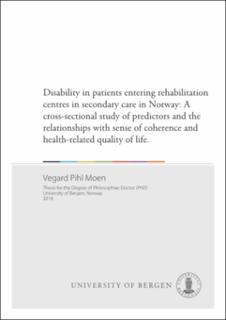| dc.description.abstract | Background: According to the World Health Organization 15% of the world s population has some form of disability, and rehabilitation is the main health strategy to target disability. There is limited knowledge about patients entering rehabilitation centres in secondary care in Norway. Age, sex, and referral health condition are reported by the health authorities. A national standard is lacking for measuring the main variable in rehabilitation: disability. Furthermore, targeting patients resources so that they can gain better control over their life situations and improve their health status is emphasized for rehabilitation by the national health authorities. The aim of this study was to increase the knowledge basis of health characteristics with respect to disability in patients entering rehabilitation centres in secondary care. To accomplish this, we aimed to clarify conceptual models of disability and how disability can be measured. Finally, with respect to clinical implications, we aimed to increase understanding of how to reduce disability and promote health. The specific objective for the first part of this work was to evaluate the measurement properties of the Norwegian version of the World Health Organization Disability Assessment Schedule 2.0 (WHODAS 2.0) in Paper I. The second objective was to assess disability among rehabilitation patients and its predictors (Paper II). The third objective was to investigate the role of sense of coherence (SOC) and its relation to disability and health-related quality of life (HRQoL) in Paper III. Materials and methods: This thesis is based on data from a cross-sectional study. All patients in the Western Norway Health Region that were accepted for inpatient or outpatient rehabilitation at a rehabilitation centre in secondary care during the first half of 2015, and who were referred from hospitals or general practitioners, were invited by mail or at admittance. Each patient completed a comprehensive questionnaire before entering the rehabilitation centre. A randomised sample of patients invited by mail completed the WHODAS 2.0 a second time, within 5 15 days after the first completion to assess reproducibility (Paper I). To assess responsiveness of the WHODAS 2.0, another randomised sample completed the WHODAS 2.0 approximately 4 13 weeks after discharge from the rehabilitation centre. For definitions, taxonomy, and terminology, Consensus-based Standards for the selection of health status Measurement INstruments (COSMIN) was followed in Paper I and tests of reproducibility, construct validity and responsiveness were performed. In Paper II, the distribution of disability was assessed using descriptive statistics. Sociodemographics and health variables were investigated as predictors for disability in regression analyses. In Paper III, SOC was investigated as a predictor for disability in regression analysis, and two hypothesized models including SOC, disability, and HRQoL were examined using structural equation modelling. Results: In Paper I, the intraclass correlation coefficient was 0.87 for total disability score, with a range of 0.63 0.84 for domain scores. For construct validity, 6 of 12 expected correlations were confirmed, and confirmatory factor analysis did not reach a satisfactory fit with the original structure. For responsiveness, three of eight hypotheses were confirmed. In Paper II, the mean total disability score (SE) was 30 (0.5), with the six domain scores ranging from 11.9 to 44.7. The following variables were found to predict higher total disability score: neurological diseases, multimorbidity, low education, impaired physical fitness, pain, and symptoms of depression. For all disability domains of WHODAS 2.0, a lower Hospital Anxiety and Depression Scale (HADS) score predicted lower disability score. Paper III showed that SOC score was associated with reduced disability scores in the following domains of WHODAS 2.0: Cognition, Getting along, and Participation. Two structural models were compared for variables with direction of the association from SOC to HRQoL and disability or with disability as a mediator. Better SOC led to reduced disability which led to better HRQoL. The mental component of HRQoL had better model fit than the physical component. For both models, circulatory diseases reached a good fit whereas less good fit was reported for musculoskeletal diseases. Conclusions and implications: This study supports the use of WHODAS 2.0 as an instrument to investigate disability among rehabilitation patients. Our findings indicate that the instrument has limitations in detecting short-term changes after discharge from a rehabilitation centre. A moderate total disability score was found among patients entering a rehabilitation centre. The fairly high score in the disability domain of Participation, in addition to the domain Life Activities, should be considered when developing rehabilitation strategies. Disability may be reduced by targeting its predictors. Our results indicate that higher SOC decreases the score in disability domains with mental components. The role of SOC in relation to disability and HRQoL might vary between diagnostic groups. In rehabilitation, SOC could be a target for enhancing mental components of HRQoL, especially among patients with circulatory diseases. | en_US |
| dc.relation.haspart | Paper III: Moen VP, Eide GE, Drageset J, Gjesdal S. Sense of Coherence, disability, and health-related quality of life: a cross-sectional study of rehabilitation patients in Norway. Archives of Physical Medicine and Rehabilitation. 2019;100(3):448-57. The article is available at: <a href="http://hdl.handle.net/1956/20521" target="blank"> http://hdl.handle.net/1956/20521</a> | en_US |

